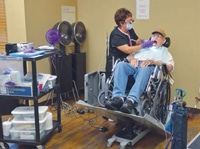
Place-Based Model of Care
Providing oral health services to residents of long-term care facilities is another option for expanding the role of dental hygienists.
Approximately 1.4 million people in the United States reside in long-term care facilities (LTCFs).1 Many of these individuals have received regular dental care and enter the facilities with healthy, well maintained dentitions. These healthy mouths begin to deteriorate, however, when individuals become unable to perform daily cleaning of the oral cavity or access necessary dental services.

The task of daily self-care often falls to the LTCF staff. Research shows that the amount of caregiver time devoted to each resident is approximately 3 hours and 50 minutes.1 During that time, caretakers are expected to assist the resident with feeding, bathing, dressing, dispensing medications, delivering therapies, administering wound care, and providing assistance with personal hygiene tasks. The role of caring for the oral cavity is still considered personal hygiene, regardless of the documented association between oral microorganisms and aspiration pneumonia.2–4 With caregivers so pressed for time, oral hygiene is often skipped or not conducted thoroughly.
When LTCF residents require oral health care, the traditional dental home is difficult to access. Barriers of costs, transportation, wheelchair accessibility, and comfort are often insurmountable for individuals residing in LTCFs.5 The concept of place-based care is ideal for LTCFs, as it allows individuals to receive dental services in the location where they reside.
TIPS FOR PROVIDING PLACE-BASED CARE
Place-based care in LTCFs removes many barriers for residents, but it creates a whole new level of challenges for dental professionals. By providing on-site care, clinicians now need to consider storage of equipment and supplies, securing a ventilated and well-lit space for providing services, and partnering with staff to ensure a steady flow of residents and support with paperwork.
Dental hygienists interested in offering place-based care should consider the following factors:6
- Refer to the terms of the state’s dental practice act before delivering dental hygiene services in a LTCF.
- Develop a partnership with a staff member in the LTCF who will build goodwill for the dental program.
- Identify a solid funding source and assign a dental team member to direct the flow of paperwork and serve as the billing contact. If the dental hygienist fills this role, be certain that administrative time is built into the schedule and that compensation is included in the budget.
- Develop and maintain a system of oral health assessment for each resident. Share assessment data with the LTCF staff members to familiarize them with existing oral conditions.
- Work with an assistant. Four hands are needed to complete care in a timely fashion.
- Invest in a wheelchair recline so that residents do not need to be moved from the comfort and familiarity of their wheelchairs (Figure 1).
- Be cognizant of the residents’ schedules; avoid planning appointments too early in the morning or during meal or activity times.
- Keep materials stored and organized at each facility, if possible. Transferring items from a vehicle daily can be time consuming and laborious.
- Invest in personal liability insurance.
- Remember that many residents will be reluctant or even resistant to having someone working in their mouths. Proceed slowly, sensitizing the patient to each new procedure. It may take multiple visits before a patient is comfortable with intraoral procedures.
Residents of LTCFs often present with poor oral health due to a lack of access to oral health care. Dental hygienists are well suited to provide essential oral health services in place-based dental homes located within LTCFs.
REFERENCES
- National Center for Health Statistics. Long-Term Care Services in the United States: 2013 Overview. Available at: cdc.gov/nchs/data/nsltcp/long_term_care_services_2013.pdf. Accessed September 24, 2014.
- Pace CC, McCullough GH. The association between oral microorganisms and aspiration pneumonia in the institutionalized elderly; Review and recommendations. Dysphagia. 2010;25:307–322.
- Russell SL, Boylan RJ, Kaslick RS, Sannapieco FA, Katz RV. Respiratory pathogen colonization of the dental plaque of institutionalized elders. Spec Care Dentist. 1999;19:128–134.
- Marik PE, Kaplan D. Aspiration pneumonia and dysphagia in the elderly. Chest. 2003;124:328–336.
- Jablonski RA, Swecker T, Munro C, Grap MJ, Ligon M. Measuring the oral health of nursing home elders. Clin Nurs Res. 2009;18:200–217.
- Branson BG, Simmer-Beck M. Addressing the oral health needs of long-term care facility residents. Dimensions of Dental Hygiene. 2013;11(8);31–35.
From Perspectives on Dental Hygiene, a supplement to Dimensions of Dental Hygiene. November 2014;12(11):38–39.

